Shroud of "Turin" and Simon Magus
Another thread that leads to Edessa as the probable capital of Adiabene during and after Jesus' time is in itself worth investigating. Following Jesus' resurrection—or, for the nonbeliever, disappearance from his tomb—his mother, Mary, takes the cloth her son is wrapped in on a journey into history. The "Shroud of Turin," as it is generally known, has generated enough interest to almost rate a field of research of its own. Heated debates continue to this day over the authenticity of this cloth, which begins its journey as the Shroud of Edessa centuries before its "discovery" in 1357 (See also the illustration of Jesus' burial, Pray Codex, National Library, Budapest, Hungary. The shroud, its unusual weaving, and an L-shaped patch near the hands that matches the relic, details recorded in 1192-95, disprove any 14th century “discovery” or manufacture claims). This cloth is known as the Cloth of Edessa, named after the ancient royal capital of Adiabene, where it is held from shortly after the time of Jesus until the year 944. The crucial insight that the Cloth of Edessa and the Shroud of Turin are one and the same was made only recently by Ian Wilson, who published his investigation in The Blood and the Shroud in 1998. His book includes a detailed chronology, and many of the facts below originate from his work.
Eusebius, gives us an account of the early history of the Cloth of Edessa in his work Ecclesiastical History written around 325. He tells how the king of Edessa, Abgar V, hears of Jesus' ministry, and sends Jesus a letter asking him to come and heal him. Eusebius found this letter in the Library of Edessa, and he quotes from it verbatim. He also relates Jesus response, which is that he could not come because he had to complete all that he had been sent to do. Jesus however assures the king that a disciple will be sent to the king, after his (Jesus') death, to bring about his healing. According to Eusebius, the public records at Edessa identify that disciple as Thaddeus, one of the “seventy, who began in the power of God to cure every disease and weakness, to the astonishment of everyone.” Eusebius does not mention a cloth bearing the image of Jesus, but other early traditions recount how such a cloth is brought to the king of Edessa to heal him. Grant Jeffrey, in Jesus: The Great Debate, notes, “History reveals that this city became a stronghold of the early Christian Church in the centuries following Abgar.” There are numerous ancient church paintings and even images on coins that depict the face of Jesus on a cloth being displayed in ancient Edessa.”
So how does the cloth Jesus was wrapped in get to Edessa? According to early traditions, it is brought there by Thaddeus, a probability supported by paintings, and images on coins depicting Jesus' face on a cloth, of that era. We also know from the Christian priests' breviary that Thaddeus and his brother, Simon the Canaanite meet in Persia. However, since Persia does not exist in the days of the apostles, the gospels correct this mistake by redefining this meeting place as the land of:
"Parthians and Medes and Elamites, and inhabitants of Mesopotamia..." (Acts 2:9-10).
An extensive examination of such works as those undertaken by Western researches published under the title The Kingdom of Adiabene and Hatra and others, lead us to hypothesize that Mary, Jesus' mother takes the shroud first to Hatra, a Parthian city where a huge church of the Magi Faith, had been erected, and that it is from here that she takes it to Edessa, accompanied by Mary Magdala, Simon the Canaanite and his brother, Thaddeus. Therefore, it is very likely that King Abgar considers the delegation fulfillment of Jesus' earlier promise to send his disciple to heal him. Further, the sight of the shroud may have convinced him of Jesus' divinity. In any case, it seems important to look into the identity of an oft-mentioned yet mysterious member of this delegation, Simon the Canaanite.
It is an understatement to say that the Simons associated with accounts about Jesus are difficult to identify and follow. We know of at least four Simons. One is the father of the Jewish infiltrator, Judas. Another is Lazarus' father. Still another is Jonah's son, the disciple Jesus named Peter, the "rock" upon which the Church of the Jesus Faith he is to found. Finally there is Thaddeus' brother, Simon the Canaanite. Considering Jesus' foresight, wisdom and good common sense, it is understandable that if he has two Simons, he would have to rename them to differentiate one from the other. And what better way to do so than by calling them according to their future assignments, or “callings”? We know that Simon Peter's calling is to found and lead Jesus' Church12. So that leaves Simon the Canaanite's assignment to determine. And here, the waters really get muddy.
In Acts 8, the "holy" scriptures give quite a confusing account of the activities of a certain Simon. Of significance is that, according to these scriptures, this Simon is practicing what the Acts call "demonic magic" during the time Rabbi Saul is conducting his house-to-house search for Jesus' following:
"Saul began ravaging the church, entering house after house, and dragging off men and women, he would put them in prison" (8:3).
Also, it is this same Simon, who "astonished the Samaritans with his demonic wizardry," and after linking up with the apostle Philip, "Samaria had taken in God's verb." Luke also mentions Simon as the one they call Zealot. This word, zealot, is explained as meaning spirited. However, “zealot” and “demonic magic” are represented in the Acts by the same symbol, which also means magus. And here, we reach a chapter in the history of Christianity that could fill a library, a collection of studies under the title Simon Magus. But we have more than just historical documentation: we have a whole series of legends that accompany this mysterious person. Reading the Acts, we cannot help but ask, what exactly does this Simon do to "astonish the Samaritans"? What supernatural powers does his "astonished" audience see in him? How does he benefit from his supposed "practice of demonic magic?" Is he a follower of Jesus, or is he a hypocrite or deceiver? What precipitates Peter's and John's success, upon their arrival, in distributing the Holy Spirit simply by "touch of hand"? And why is John a quiet and reserved observer during his encounter with Simon Magus?
It is impossible to come to any logical conclusion from this deranged account of events. So, the next step is to look up Eusebius' account:
"Simon instituted the greatest heresy, and his followers, just as Morcion, too, rejected the Old Testament which they consider writings from the realm of evil" (Hist. II, 13. 1-8).
Yet, according to Justin:
"All of Samaria practices the teachings of Simon about Jesus" (Apol. 1:6).
According to these accounts, the Jews call Simon a heretic, while Simon teaches the Samaritans about Jesus, and his followers call the Jews' Old Testament “writings from the realm of evil.” So where do we go from here? Fortunately, we get a break in the Dictionary of Christian Biography (IV. 1887. p. 681-688), referencing George Salomon, in the Chapter, Simon Magus. Here, he tells us that the discussion between Peter and Simon related in the Acts of the Apostles is actually a debate between Peter and Paul. Therefore, George Salmon identifies the man the Acts call Simon Magus as Paul. And this is where the cat gets out of the bag. It now becomes crystal clear why Rabbi Saul changes his name to Paul, rather than some other name, to pass himself off as Jesus' apostle. Jesus gives Simon the Canaanite the name “Pal” (Pál, Hungarian for Paul), a word that defines his calling. This word is a Sumerian symbol (the arrow) used to denote "calling" in reference to the symbol it traverses. This symbol can be found in the dictionaries of Deimel and Labat (9). Here is a 3rd millennium BC representation of this compound symbol.

The symbol the arrow traverses is that of the Holy Trinity and, combined, the two symbols mean "advocate, teacher, guardian of the Holy Trinity." This is the assignment (calling) Jesus gives Simon the Canaanite in their common native Aramaic language. His job is to advocate, protect, guard the Holy Trinity.
It is also clear that Rabbi Saul finds it important to spare no effort to establish the memory of Simon the Canaanite as the "demonic Simon Magus." It is vital to Saul's success as an impostor to permanently detach Simon from the name Pal. And to a great extent, he succeeds. Roman Orthodoxy destroys all the evidence of Simon's “Pal” name it can find, evidence that could undermine Saul's appropriation of that name. Henceforth, Saul can pass himself off as Pal, Jesus' apostle by parroting off selected bits and pieces of information he had extracted from Jesus' captured following and from his informant (and possibly, brother) in Jesus' circle, Judas. In substance, his identity-theft is a repeat of Jacob's appropriation of the name Izrael to run a scam.
How Saul came to know about Simon's “Pal” name remains a mystery. Conceivable theories source this information from Judas who most likely knew, or from Jesus' followers who broke under torture. What is self-evident, is that he does not choose just any name: he specifically takes on the name Pal, English Paul, and thus becomes the founder of the new Jewish sect, an instrument of subjugation of Gentiles called Roman Christianity, all "in Jesus' name."
Rabi Saul's claim that he became a convert when Jesus appeared to him in a vision is as incredible to Peter as it is to the thinking man today. Put bluntly, the disciple Jesus entrusted with founding his Church calls the rabbi elevated to sainthood by Judeo-Christianity (Saint Paul) a liar to his face:
"If, then, our Jesus appeared to you [Saul] in a vision, made Himself known to you, and spoke to you, it was as one who is enraged with an adversary; and this is the reason why it was through visions and dreams, or through revelations that were from without, that He spoke to you.
But can any one be rendered fit for instruction through apparitions? And if you will say, 'It is possible,' then I ask, 'Why did our teacher abide and discourse a whole year to those who were awake?' And how are we to believe your word, when you tell us that He appeared to you? And how did He appear to you, when you entertain opinions contrary to His teaching?
But if you were seen and taught by Him, and became His apostle for a single hour, proclaim His utterances, interpret His sayings, love His apostles, contend not with me who companied with Him. For in direct opposition to me, who am a firm rock, the foundation of the Church, you now stand. If you were not opposed to me, you would not accuse me, and revile the truth proclaimed by me, in order that I may not be believed when I state what I myself have heard with my own ears from the Lord, as if I were evidently a person that was condemned and in bad repute.
But if you say that I am condemned, you bring an accusation against God, who revealed the [divine wisdom] Jesus to me, and you inveigh against Him who pronounced me blessed on account of the revelation. But if, indeed, you really wish to work in the cause of truth, learn first of all from us what we have learned from Him." (Peter's reply to Saul, Clementine Homilies, Pseudo-Clemens, 17:19).
Peter's reply not only reveals his disbelief of Saul's fabrications but also says a lot about Peter. It is self-evident that this articulate man possesses a much higher education and level of thinking than would be expected of a simple fisherman, as propagated by Judeo-Christianity. And when combined with the organizational and administrative skills needed to found Jesus' first Church, in Antioch (Acts 11:26)—and later, Babylon (1 Peter 5:13)—it is more than probable that he was not only an intellectual but also a magus himself (Antioch had been under Roman control since 64 BC as a “civitas libera” [“free city” in northern Canaan, today's Turkey, near the Syrian border] inhabited by Greek-speaking non-Semitic people, followers of the Milki-Ilu (Melchizedek) faith. The people of Antioch receive Peter with open arms as Jesus' ambassador, but oust Rabbi Saul when he tries to spin his web of deceit there. Despite good evidence of Peter's burial in Antioch, the Church is still looking for him in Rome, hoping to find some evidence to prop up its untenable dogma. But so far, nothing has been found to link Peter to Rome or to Judeo-Christianity).
During our investigation, we have also discovered the theological meaning of the Pal-ian calling (his “call sign” if we like) as the advocate, guardian of the Holy Trinity. We now understand Simon the Canaanite's works Roman Orthodoxy attributes to Simon Magus: his teaching the Samaritans about the Holy Spirit and his followers' sourcing the Jews' Old Testament from the "realm of evil." Moreover, we can also see logic in Jesus' choice in sending Simon, advocate of the Holy Trinity, to accompany the Holy Spirit incarnate, Mary, Jesus' mother, to King Abgar. Everyone, and Abgar, personally, realizes that Mary's sacred touch produces miracles such as the healing of the sick. History tells us that the incurable Abgar lives another twenty some years after Mary's visit to a ripe age of 75.
We have no reliable information on the physical appearances of Jesus as an adult, Mary, her parents or any member of the Adiabene royal family—other than Jesus' (much-debated) image on the Shroud of Edessa (Turin). The closest we can find are statues (in Hatra) of Jesus as a child (raised right hand broken), Adiabene's king, Sanaturk (91-109 AD) and his wife (both from Girschman), the succession since Abgar V (“The Great,” 13-50) being his son, Marina V (50-57), Marina VI (57-71), and Abgar VI (71-91). (The name Marina is read [by Badiny] Ma-Ri-Na, literally, “Man of the Mother Goddess” from Gutschmidt, 1876.) Nevertheless, these statues—physical appearance, dress, the royal crown, the princess' headgear, and hand sign—provide clues of their physiques, traditions and beliefs. Of significance are the trousers—as opposed to robes, the customary garment of other cultures—worn by both the child Jesus and the king, the Turul (falcon) on the king's crown and the sun halo around both Jesus' head and the “Son of Light,” in the princess' head ornament. The raised hand is a greeting sign of openness (the lines of the palm are believed to reveal ancestry, character and destiny). This custom is still practiced in some isolated Magyar villages when adolescents meet their dates. Later, the young man proposes by showing both his palms. The girl then “reads his lines” and, if she accepts him, covers his palms with hers.
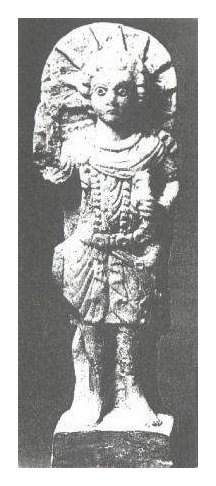
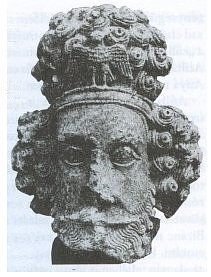
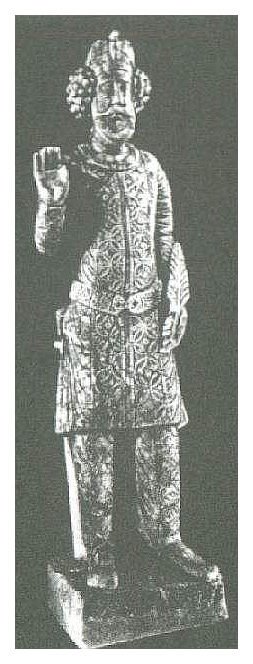
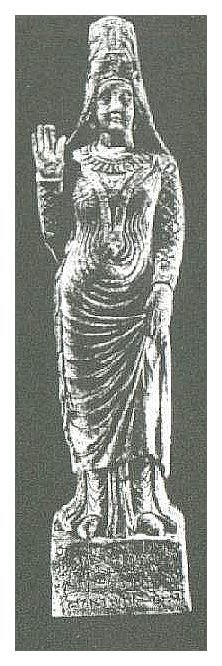
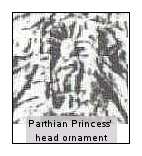
______________________________
12. The word "peter" is the English variant of the Latin "petrus, perta," from Greek, "petros, petra," rock, claimed to be the translation of Aramaic "cepha, cephas, kepha. kephas, kepa, kepas," stone, rock, bedrock. Hungarian "kő, köves, kövesd" means stone or rock, rocky (place), bedrock, but "kövesd!" also means follow him!

